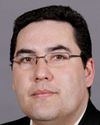I'd like to thank the committee very much for the opportunity to come to speak with you today and share some of our perspectives on aboriginal education. The clerk informed me that you're focusing particularly on post-secondary education, and we'll try to guide our comments towards that outcome, but certainly we share a perspective that education includes a broader field for consideration.
I'd like to start with a very brief summary--I know I have around ten minutes to speak here--about who we are and about our structure.
Page 6 has a map, showing where the friendship centres are located across the country. Hopefully, there's one in each of your ridings: if not, let's talk afterwards, and we'll try to get one. The only province or territory we aren't currently involved in is P.E.I. Charlottetown in P.E.I. is doing a lot of work towards the development of a centre in that community.
Friendship centres are service delivery organizations in communities across Canada. There are currently 117 from coast to coast to coast. Our mandate is primarily to administer the aboriginal friendship centre program on behalf of the federal government, but in doing that we touch all of Canada's aboriginal peoples--first nation, Métis, and Inuit--irrespective of political or legal definitions, through really basic bread-and-butter services every day.
We are very much community-driven. We provide funding to local friendship centres and support to their boards. We establish administration standards for those friendship centres, in the level and type of administration they need to provide. We also provide some other programs on behalf of government partners.
With respect to our process, I'm from the National Association of Friendship Centres. We're really at the bottom of the pyramid, which includes--in the last year we collected full stats--757,000 client contacts across the country through 117 friendship centres. We have seven regional bodies, and we're the national body. We also have a national senate and a youth council to support our activities as well.
I won't spend too much time on the stats--I'm sure you know them better than I do--but according to the 2001 census, 71% of all aboriginal people live off of reserves, and 68% of that population live in urban areas. That's a fancy way of saying just about 50% of all aboriginal people live in urban areas.
We know from the same stats that the urban population is growing: in some cities it has quadrupled. In other areas it's going to continue to grow over the next 25 years. Fifty percent of the population is under the age of 25. And with your focus on education, of course you know that 50% of all aboriginal people do not graduate from high school.
So what in effect we have is a growing underclass in this country of young, urban, uneducated aboriginal people. Unless we do something this generation with the issue, it's only going to grow.
As I said, currently there are 117 friendship centres across the country. These community agencies and the program that funds them really are enablers for many other programs that we can provide on behalf of the federal government--we have some examples there for you. It's important to note that in addition to every dollar we receive in core funding, we receive on average approximately $9 from other government programs. So our program isn't funded solely through the aboriginal friendship centre program. We certainly do a lot of other things through other federal and various provincial and municipal programs.
Naturally, friendship centres offer that first point of contact, a welcoming environment, and access to a broader community. I won't get into the list of programs and services that friendship centres provide, but it's varied. We like to say we try to provide a cradle-to-grave kind of programming cycle, everything from prenatal to early learning and child care programming, to programming to young people in communities, for those who have dropped out of school, to programming for adults who run into difficulties in their lives, through various education programs, to drug and alcohol counselling, to homelessness programming outreach, to support for our seniors, all in a culturally appropriate manner.
Friendship centres started in the early 1950s as aboriginal people began to migrate into urban areas for a variety of reasons. There's a brief history there outlining our growth, and where we are today with the 117 centres across the country.
As you know, with respect to off-reserve education issues, half of our people are not graduating right now, for a variety of reasons. The reasons cited for non-completion of post-secondary studies for men were primarily financial, while those for women, most frequently cited of late, were related to family responsibilities. While some post-secondary outcomes show signs of improvement, the percentage of non-reserve aboriginal people with post-secondary education is significantly lower than the same for the total Canadian population.
Friendship centres are involved in education in a variety of formats. I briefly referred to the cradle-to-grave notion. We're involved in early childhood education through a variety of programs like aboriginal head start programs and community action plan for children programs. We're involved in various adult literacy and upgrading programs, and we provide scholarships.
At the National Association of Friendship Centres we named a scholarship after one of our senators, Delia Gray. Youth are involved in the friendship centre and some funding helps their post-secondary studies.
We have a number of alternative schools across the country; we have eight in Ontario right now and a couple of others sprinkled throughout the country. These are initiatives aimed at giving aboriginal people who have already dropped out of school an opportunity to get back into education and finish school. Some of the most interesting programs are not just in friendship centres. There are a couple of exciting schools in Winnipeg. In Toronto there's one involved with the friendship centre movement. There's a growing groundswell of on-the-ground community education programs and that needs to be supported.
We're involved in other types of programs related to education, like computer training and aboriginal language--too often when we talk about education we forget about our own cultures and our own communities. We're involved in a variety of cultural supports associated with that as well.
In general, urban aboriginal education programs have taken a very much first nations status Indian approach, much in keeping with the federal government's responsibilities. The current policy environment has very much focused on a distinction-based approach, most recently reflected in the Kelowna accords. During the negotiations for the Kelowna accords we were concerned about how the urban aboriginal issue was being dealt with in that context. The creation of first nation school boards, while important and supportive, isn't going to help a single aboriginal woman in downtown Winnipeg finish school or help her child get into an early learning program so ultimately that child can go to post-secondary education. So we were calling for an expansion within that context, within the targets, of how to reach that urban population through creative measures like alternative schools.
We believe a specific urban approach is required, while not shying away from previous commitments because we do believe those commitments under the Kelowna accord need to be met. And programs must help that mythical single aboriginal woman in a downtown community if they're to have impact.
As we mentioned, with respect to post-secondary education, it's one piece in a larger continuum that needs to be addressed. We have early learning programs so our young people have successful starts. We have K to 12 programming for those who are having problems in mainstream schools. We have alternative schools for those who have dropped out, so they will have other ways to get back into the public education system. We need literacy programs to help those adults who already have not made it and are looking for opportunities to get back into school.
If you look at early learning and child care, more than 112,000 children under the age of six are living off reserve, and 16% of six-year-old aboriginal children living off reserve had attended a pre-school program. That's certainly not the kind of access we need to make sure these kids are getting the start they need. According to the 2001 aboriginal peoples survey, 42% of six-year-old aboriginal children living off reserve had not attended pre-school at all.
We need an early learning and child care program that's based on successful community-based initiatives from every region of the country. We need to take an approach that ensures direct service delivery to urban aboriginal people--an approach that doesn't make them have to be a status Indian, belong to a certain Métis community, or come from certain regions of the country. We call that a status-blind approach. We need to target specific needs of aboriginal children living in communities as opposed to blanket programs across the country.
We're calling for various constituent early learning and child care programs offered in centres across Canada to be included in the national early learning and child care programming notions thought of in the previous government.
There are a variety of actions we can take for the K to 12 programs as well. It's clear we need better engagement with provinces and territories around this issue because the jurisdictional land mine that is an urban aboriginal person continues to pervade. But any serious examination of aboriginal education can include shirking of responsibility.
We need better and better-funded native alternative schools, again, partnerships with provincial programs and local school boards. We need strengthened relationships with first nations communities and organizations to make sure our efforts work together. Quite often we tend to be pitched against each other in the urban first nation reality and we need to make sure that we're working toward the same end.
With respect to post-secondary education, only 23% of aboriginal people aged 18 to 29 reported having completed post-secondary education, compared to 43% in the rest of Canada. That is probably best indicated in the age group of 30 to 34, where 10% of the aboriginal population was back in school full-time versus only 5% of the mainstream population. People are dropping out. The public school system is failing their kids. Once they try to work and succeed for a while, they find other avenues to get back into the school system. We need to find ways of catching them once they do drop out and to make sure they have opportunities to get back into school.
We have partnerships with groups like the Canadian Council of Learning, looking at the issue of high aboriginal youth dropout rates. We're partnering with them on a stay-in-school comic book. We're focusing on literacy programs and making sure kids understand the impacts of what happens when you drop out of school, and we are focusing on kids having opportunities to get reintegrated into community-based initiatives.
Moving forward, the National Association of Friendship Centres believes that we need to recognize the specific urban needs that exist; and policy approaches such as these must be taken into account when developing post-secondary education initiatives to reach non-status Indians and people with other aboriginal identities.
We obviously need a national early learning and child care program; we need to strengthen engagements with provinces and individual school boards; we need better supports and more native alternative schools across the country; we need to have strengthened relationships with first nations and their organizations in the delivery of education initiatives; and we need to have more inclusive scholarships that include all of Canada's aboriginal people.
Thank you very much, Mr. Chairman.






